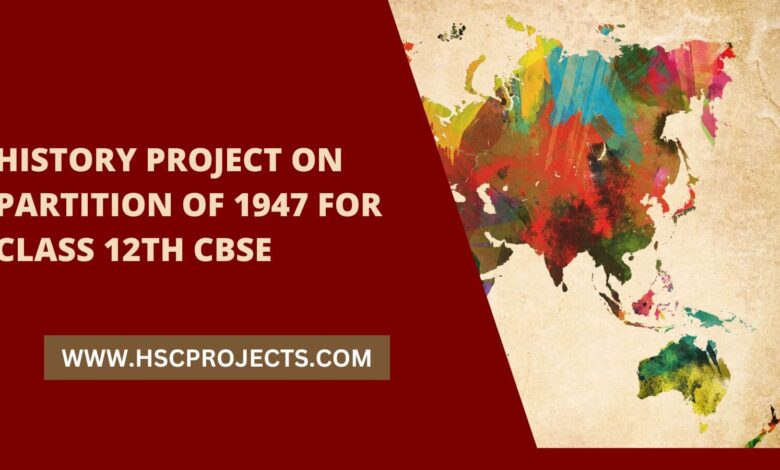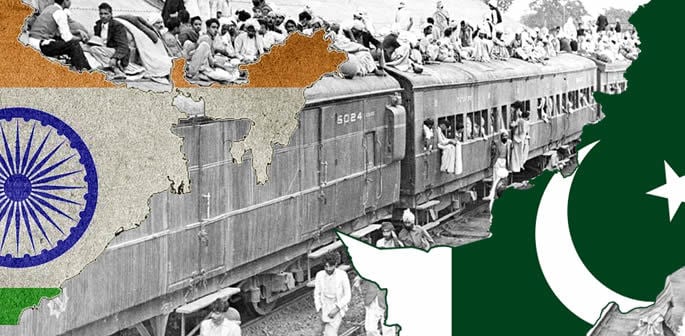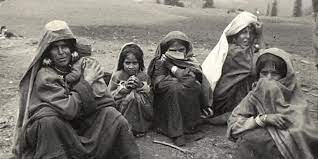
History Project On Partition Of 1947 For Class12th CBSE
Introduction
In 1947, the British colonial authority in India came to an end, and two new countries, India and Pakistan, were born. It was a pivotal moment in South Asian history, precipitating widespread death and destruction and forcing the relocation of millions of people.
After years of sectarian tensions between Hindus and Muslims in India, which the British strategy of divide and rule only served to deepen, the Partition finally occurred. In the years running up to independence, the All India Muslim League’s proposal for a separate country for Muslims in India gained traction.
Tensions and disputes between India and Pakistan persist to this day on contentious subjects like the contested area of Kashmir, a legacy of the Partition. It is essential to South Asian history and politics that we comprehend the Partition and its effects.
Partition Of India

In 1947, British India was partitioned to create the independent nations of India and Pakistan. The British administration, after consulting with Indian leaders, decided to split the nation in two on August 15, 1947.
The All India Muslim League, led by Muhammad Ali Jinnah, was largely responsible for pushing for Partition because they wanted a separate state for Muslims in India. To safeguard Muslim interests and guarantee their participation in Indian politics, the Muslim League contended that Muslims in the subcontinent need their own independent state.
As a result of the Partition, millions of people were killed or displaced as they attempted to cross the newly formed boundaries between India and Pakistan. Mobs and militias often attacked minority groups, especially Hindus and Sikhs in Pakistan and Muslims in India.
The Partition drastically altered the area, forcing millions of people to leave their homes and seek refuge in other nations. It also contributed to the perennial hostility between India and Pakistan over Kashmir and other contentious matters. Partition’s effects on South Asian politics and culture are being felt today.
The End Of The Raj
The word “Raj” is used to refer to the time when India was under British control, which was from 1858 to 1947. The partition of India and the subsequent establishment of two independent states, India and Pakistan, marked the official end of the Raj.
A major factor in the demise of the Raj was the growing strength of the Indian independence movement over many years. Prominent leaders including Mahatma Gandhi, Jawaharlal Nehru, and Subhas Chandra Bose pushed for India’s complete freedom from British control and were instrumental in leading the independence struggle.
When it came time to negotiate with the British administration, it was the Indian National Congress—the primary political party of the independence movement—that was instrumental. The Muslim League’s rejection of the Cabinet Mission Plan, which called for a unified India with distinct Muslim-majority and Hindu-majority areas, was a crucial factor in the subsequent partition of India.
India’s independence from colonial authority at the end of the Raj was a watershed moment in the nation’s history. However, it was not without its difficulties, such as the necessity to reconstruct the nation after years of British exploitation and the difficulties of division and mass migration. Politics and culture of India and the rest of South Asia are still heavily influenced by the British Raj.
Regions Affected By The Partition
Significant changes occurred in several parts of the Indian subcontinent after the 1947 Partition of India. Millions of people were uprooted because the nation was split over religious lines, and many lives were lost.
Punjab was one of the most hit areas when it was split in half, with half going to Pakistan and the other half going to India. Millions of Hindus and Sikhs were forcibly relocated to East Punjab from West Punjab, while millions of Muslims were similarly relocated in the other direction, as a consequence of the partition of Punjab.
The Partition had a profound impact on Bengal, as well. East Bengal was annexed by Pakistan and ultimately became Bangladesh, while West Bengal was incorporated into India. Millions of people were compelled to leave their homes as a direct consequence of Bengal’s partition.
The territory of Jammu and Kashmir, which is also known as the Partition, was also influenced by the Partition, with the Maharaja of the region choosing for the Partition. As a result, India and Pakistan have been embroiled in a never-ending cycle of fighting over the area.
Tensions between India and Pakistan persist, as individuals displaced by the Partition struggle with questions of identity and belonging decades after the event.
Resettlement Of Refugees
Millions of people were compelled to leave their homes in India and go to Pakistan when the country was “Partitioned” in 1947. Mobs and militias often attacked minority groups, especially Hindus and Sikhs in Pakistan and Muslims in India. Millions of people were uprooted as a result of this, creating a refugee crisis of unprecedented proportions.
When it came to helping refugees, the governments of India and Pakistan adopted opposing tacks. The Indian government helped individuals uprooted by Partition by establishing refugee camps and distributing aid. When people in India were uprooted, lawmakers established the Displaced Persons (Compensation and Rehabilitation) Act to help them rebuild their lives.
At first, the government of Pakistan did not provide substantial help to asylum seekers. As the magnitude of the refugee situation became clear, however, the government established refugee camps and began providing aid to individuals who had been uprooted by the Partition.
There were a lot of hurdles and impediments in the process of resettling migrants. Many displaced people had trouble adjusting to their new environments, and they often felt like outsiders or no longer part of society.
India and Pakistan continue to have lingering difficulties over citizenship and refugee rights as a direct result of the refugee crisis that began in the 1970s.
Population Transfer And Violence
There was a massive population shift and outbreak of violence during the Partition of India in 1947. Mobs and militias often attacked minority groups, especially Hindus and Sikhs in Pakistan and Muslims in India.
Millions of people were displaced as a result of the population shift, and many had to go across the newly established boundaries between India and Pakistan. Most of the emigration was motivated by religious affiliation, with Hindus and Sikhs leaving Pakistan for India and Muslims leaving India for Pakistan.
The Partition was followed by widespread and terrible bloodshed. As many as two million people may have lost their lives as a direct consequence of the bloodshed, according to some estimates. Many women were kidnapped, sexually assaulted, and died because of this.
India and Pakistan are still influenced by the bloodshed and demographic shift that occurred after partition. Both nations’ collective memory is scarred by the events of 1947, and questions of identity and belonging continue to dominate political debate in the area.
Missing People
As a result of the Partition of India in 1947, millions of people were forced to relocate: Muslims left India for Pakistan, while Hindus and Sikhs left Pakistan for India. Thousands of individuals disappeared during the Partition as a consequence of the huge exodus and bloodshed that ensued.
It is unclear how many individuals vanished during the Partition, although estimates place the figure in the tens of thousands. The anguish of having loved ones go missing has lingered in the communities that lost members of their own families who were never found.
During the Partition, many military personnel and prisoners of war went missing along with civilians. While the governments of India and Pakistan made efforts to find and return captured soldiers, the hunt for missing civilians proved far more challenging.
Many years have passed after the Partition, but families still haven’t found answers or closure about their lost loved ones. The human cost of the bloodshed and dislocation that took place in 1947 is best shown by the subject of missing individuals, which remains a terrible and unsolved legacy of the Partition.
Rehabilitation Of Women

There was widespread violence, including sexual abuse against women, during the Partition of India in 1947. Countless women were kidnapped, raped, and murdered; many more were rendered homeless and impoverished.
Both the Indian and Pakistani governments made attempts to help women who had been harmed by the Partition and to help them rebuild their lives. For Indian women who had lost husbands or children to the violence, the government opened rehabilitation centres and gave financial aid. The Indian government has enacted legislation to safeguard women’s rights and curb domestic abuse.
Pakistan’s government also established rehabilitation centres specifically for women to help those who had been victims of violence. However, many women continued to endure prejudice and abuse in the years after Partition due to insufficient support services.
It was a long and complicated task to help women recover from the trauma of the Partition. There was widespread discrimination and isolation for women. Women who had been removed from their communities also had trouble redefining who they were and what they stood for.
Women in India and Pakistan have been affected profoundly by Partition’s bloodshed and upheaval. Gender and identity issues continue to be at the forefront of political debate and social justice initiatives in the Middle East.
Perspectives
The political and social makeup of the area was profoundly altered by the Partition of India in 1947. Religion, race, nationality, and individual experience all have a role in shaping people’s views on the Partition.
After centuries of persecution and murder at the hands of Muslims, many Hindus and Sikhs in India saw the Partition as a necessary and right reaction. As a result of Partition, they believe India has emerged as a secular, democratic state.
Many Muslims in Pakistan consider the Partition an act of treachery since it resulted in the uprooting and hardship of millions of Indians. Pakistan, in their eyes, is both the motherland of Muslims and a symbol of defiance against Hindu expansionism.
Many other people, including as minorities, women, and the marginalised, have their own unique viewpoints on the Partition. Many people were uprooted because of the Partition, yet others saw it as a necessary evil for the birth of new countries.
Perspectives on the Partition are nuanced and varied, and they remain a hot topic of discussion and controversy in the area even now. To fully grasp the complex history and politics of the area, it is essential to get familiar with the many viewpoints on the Partition.
Immediate Consequences And Effects Of Partition
In 1947, when the Partition of India occurred, the repercussions were rapid and far-reaching. These are some of the most notable results and outcomes:
Violence and Displacement: Millions of people were uprooted from their homes and compelled to seek refuge in neighbouring countries as a direct consequence of the massive violence and dislocation caused by the Partition. Hundreds of thousands of people lost their lives, and the communities were permanently traumatised by the carnage.
Political Unrest: The new nations of India and Pakistan struggled to establish themselves and cope with the aftermath of the bloodshed and dislocation that followed the Partition.
Economic Disruption: Due to the loss of commerce and infrastructure, many people in India and Pakistan fell into economic hardship and poverty as a result of the Partition.
Population Transfers: Millions of people had to be moved because of the Partition, and this has had lasting effects on the politics and culture of the area because of questions of citizenship, identity, and belonging.
Legacy of Violence: Issues of communal violence and identity continue to be serious concerns in India and Pakistan, a legacy of the bloodshed and sorrow of Partition.
The Partition had far-reaching repercussions, which are being felt today in the region’s politics, society, and culture. A fuller comprehension of the Partition’s complicated and multidimensional history requires an understanding of these effects.
Timeline
- The year 1857 marks the beginning of the Indian Rebellion against British authority.
- The Indian independence movement officially begins with the establishment of the Indian National Congress in 1885.
- In 1906, a group calling for a Muslim homeland in India called the All-India Muslim League was established.
- In 1940, the Muslim League adopted the Lahore Resolution, which pushed for the establishment of a Muslim homeland in India.
- On March 24th, 1947, the British administration declared its intention to give over control to the Indian government.
- Partition of India into India and Pakistan was announced by the British government on June 3, 1947.
- On August 14, 1947, Pakistan became an independent republic under Muhammad Ali Jinnah’s leadership.
- On August 15, 1947, British authority over India ended, and Jawaharlal Nehru became the country’s first prime minister.
- Between August 16 and 31, 1947, millions of people are displaced as a result of the Partition and the ensuing violence and border crossings.
- The British Raj officially ended on September 30, 1947, when the last British soldiers left India.
- In 1948, religious tensions after the Partition are highlighted by the assassination of Mahatma Gandhi at the hands of a Hindu nationalist.
Conclusion
The partition of India in 1947 was a watershed moment with global repercussions. It was the turning point that led to the separation of India and Pakistan from British rule. The tremendous bloodshed, upheaval, and pain caused by Partition are a tragic aftereffect that continues to colour the region’s politics, social fabric, and cultural expressions to this day.
Religious, political, and economic difficulties, as well as the legacy of British colonial control, all had a role in causing the Partition. Millions of people were forced to flee across freshly formed boundaries, sparking conflict, homelessness, and loss of life. The new countries of India and Pakistan had a tremendous task in the resettlement and rehabilitation of refugees, many of whom were impoverished, traumatised, and felt they had lost their identities.
Conflicts over identity, citizenship, and sectarian tensions continue to define contemporary politics and culture in the area, a legacy of the Partition of India. People-to-people interaction, cultural exchanges, and debate are all examples of initiatives that aim to address the Partition’s aftereffects and foster peace and reconciliation.
In sum, the Partition of India was a painful and intricate event, the repercussions of which are still being felt today. We may better grasp the issues confronting the area and the value of fostering peace, tolerance, and understanding by learning from its history and heritage.
Certificate of Completion
I, [Student’s Full Name], hereby certify that I have successfully completed the History project on “Partition of India in 1947” as part of the CBSE Class 12 curriculum at School Name. The project was undertaken during the academic year [Year], and I am excited to share my learnings and experiences.
Project Title: Partition of India in 1947 – A History Project
Class: CBSE Class 12
Subject: History
Academic Year: [Year]
During the course of this project, I delved into the historical significance of the Partition of India in 1947. I explored the political, social, and cultural aspects that led to the creation of two independent nations, India and Pakistan, and the momentous changes that followed.
The project allowed me to gain a deeper understanding of the colonial era, the Indian independence movement, and the role of prominent leaders like Mahatma Gandhi, Jawaharlal Nehru, and Muhammad Ali Jinnah in shaping the course of history.
I researched the immediate consequences of the Partition, including widespread violence, displacement of millions of people, and the establishment of new political boundaries. The project also shed light on the long-term effects, such as the unresolved issues of identity, citizenship, and sectarian tensions that continue to impact the region today.
Through this project, I learned about the struggles and challenges faced by refugees during the resettlement process and the efforts made by both India and Pakistan to rehabilitate them. I also explored the perspectives of various communities and individuals affected by the Partition, helping me understand the complexities of historical events from multiple angles.
The project not only expanded my knowledge of South Asian history but also deepened my appreciation for the importance of fostering peace, tolerance, and understanding in today’s world.
I am immensely grateful for the guidance and support provided by my History teacher throughout the project. Their encouragement and insightful feedback were instrumental in shaping the final outcome.
In conclusion, I am proud to present this certificate as evidence of my dedication, research, and passion for history. This project on the “Partition of India in 1947” has been a transformative learning experience, and I hope that it contributes to a better understanding of the region’s history and the importance of unity and harmony in diverse societies.
Signature: __________
Date: __________
In order to download the PDF, You must follow on Youtube. Once done, Click on Submit
Follow On YoutubeSubscribed? Click on Confirm
Download History Project On Partition Of 1947 For Class12th CBSE PDF






